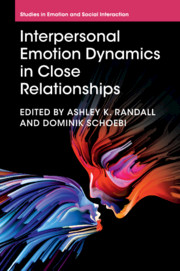Book contents
- Interpersonal Emotion Dynamics in Close Relationships
- Studies in Emotion and Social Interaction
- Interpersonal Emotion Dynamics in Close Relationships
- Copyright page
- Contents
- Figures
- Tables
- Contributors
- Foreword
- Introduction
- Chapter 1 Conceptual approaches to studying interpersonal emotion dynamics
- Chapter 2 A general framework for capturing interpersonal emotion dynamics
- Chapter 3 Simplifying the complexity of interpersonal emotion dynamics with regression graphics
- Chapter 4 Methodological approaches to studying interpersonal emotion dynamics
- Chapter 5 Biochemical contributions to interpersonal emotion dynamics
- Chapter 6 Physiological correlates associated with interpersonal emotion dynamics
- Chapter 7 Interpersonal emotion dynamics in families
- Chapter 8 Interpersonal emotion dynamics within young adult romantic and peer relationships
- Chapter 9 Interpersonal emotion dynamics within intimate relationships
- Chapter 10 Next steps toward understanding interpersonal emotion dynamics
- Author Index
- Subject Index
- Studies in Emotion and Social Interaction
- References
Chapter 4 - Methodological approaches to studying interpersonal emotion dynamics
Published online by Cambridge University Press: 14 September 2018
- Interpersonal Emotion Dynamics in Close Relationships
- Studies in Emotion and Social Interaction
- Interpersonal Emotion Dynamics in Close Relationships
- Copyright page
- Contents
- Figures
- Tables
- Contributors
- Foreword
- Introduction
- Chapter 1 Conceptual approaches to studying interpersonal emotion dynamics
- Chapter 2 A general framework for capturing interpersonal emotion dynamics
- Chapter 3 Simplifying the complexity of interpersonal emotion dynamics with regression graphics
- Chapter 4 Methodological approaches to studying interpersonal emotion dynamics
- Chapter 5 Biochemical contributions to interpersonal emotion dynamics
- Chapter 6 Physiological correlates associated with interpersonal emotion dynamics
- Chapter 7 Interpersonal emotion dynamics in families
- Chapter 8 Interpersonal emotion dynamics within young adult romantic and peer relationships
- Chapter 9 Interpersonal emotion dynamics within intimate relationships
- Chapter 10 Next steps toward understanding interpersonal emotion dynamics
- Author Index
- Subject Index
- Studies in Emotion and Social Interaction
- References
Summary
- Type
- Chapter
- Information
- Interpersonal Emotion Dynamics in Close Relationships , pp. 75 - 92Publisher: Cambridge University PressPrint publication year: 2018
References
- 1
- Cited by



